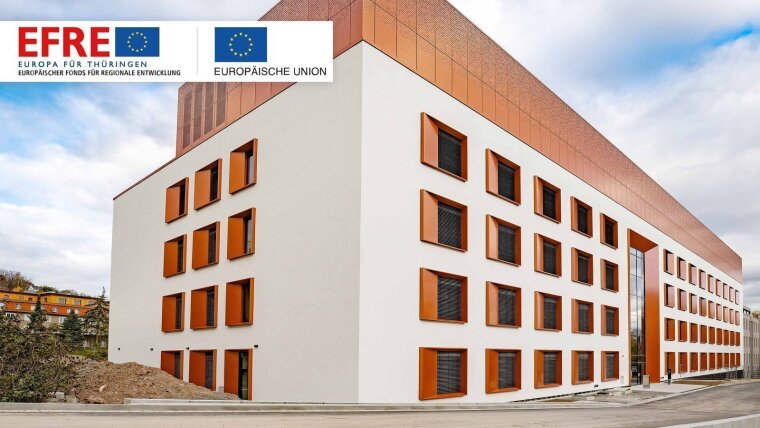
Published: | By: Sebastian Hollstein
Source article
If a building creates good news before it is completed, a lot can be expected from it. This certainly applies to the extension buildings of the Center for Energy and Environmental Chemistry Jena (CEEC Jena) the University of Jena. “The functional architecture of the new centre with its specialized laboratories has already helped us to successfully acquire coordinated programmes from the German Research Foundation (DFG) and the new Helmholtz Institute HIPOLE Jena,” explains Prof. Dr Ulrich S. Schubert. The Jena chemist and materials scientist mentions, among other projects, the successful extension of the DFG priority programme “Polymer-based Batteries” and the acquisitions of the new DFG research group “FuncHeal” as well as the Thuringian water innovation cluster ThWIC de. All of these and other projects now find space in the CEEC Jena II and the CEEC Jena Application Center (AWZ CEEC Jena), which were officially opened today (12 April, 2024).
This success story, which will be continued in the future, was certainly one of the reasons why, in addition to well-known representatives of the University and the city of Jena, the Prime Minister of the Free State of Thuringia, Bodo Ramelow, Science Minister Wolfgang Tiefensee and the Building State Secretary Prof. Dr Barbara Schönig took part.
University as a successful builder
“These new buildings show that the Friedrich Schiller University not only conducts top-level research, but can also build very well. Because we were the direct responsible builders ourselves for the first time, and the fact that we have remained almost on schedule and within budget since 2021 despite the COVID-19 pandemic shows that the trust the Free State of Thuringia placed in us was justified,” said the Interim President of the University of Jena, Prof. Dr Georg Pohnert, and thanked everyone involved in the construction as well as the sponsors.
The two parts of the building, which are divided under one roof, cost 53 million euros, which were financed by the Federal State of Germany and Free State of Thuringia with the support of the Carl Zeiss Foundation and Ernst Abbe Foundation as well as with funding from the EU (ERDF) and the University's own resources. In addition, the state supported equipment with almost 10 million euros, including, for example, a transmission electron microscope for polymer materials worth 5.5 million euros.
Exploring the future of water and energy
All of these investments ensure that Jena’s scientific community can address important (climate) relevant issues such as battery and energy research, but also numerous other research topics from chemistry, materials science and geosciences. Metal-free electrochemical energy storage (batteries, supercapacitors), photovoltaics and intelligent facades as well as innovative water technologies are being developed here. New materials will be invented, synthesized, processed, and used. And researchers from polymer and glass chemistry through to mineralogy find the best working conditions in the new buildings. A total of twelve working groups from the University and the new “Helmholtz Institute for Polymers in Energy Applications Jena” (HIPOLE Jena)External link are moving in here.
The shape of the building, designed by the architecture firm "Telluride Architektur" (formerly: HDR Germany), already presents the content: Copper, for example, refers to foils for battery electrodes. In addition, the copper color of the roof bar matches the historic clinic next door. And the roof full of solar cells for green energy supply and with test areas for own solar cells or facade components prove that sustainable research is being carried out here into the sustainability of the future.
The new building with its two parts comprises a total of 4,000 square metres of usable space and hoeses over 40 offices and 60 laboratories. A technical centre for upscaling and large devices was set up in the application centre. It is now possible to bring research results closer to possible later production and to produce and process larger quantities of the desired materials on site.
“Now, within ten years, 85 million euros plus 20 million euros for research instruments have been invested in the Landgrafen campus, in four buildings connected by bridges. This enables the University of Jena to carry out the research initiatives that began in 2010 in the fields of polymer and materials research for energy, environmental and pharmaceutical applications in a completely new quality,” said Prof. Schubert. “All of us here will now work to justify these investments by conducting top-level research and converting this into products that, in turn, lead to new jobs in Thuringia.”